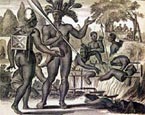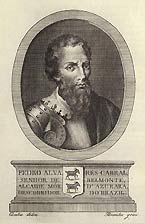

















 In the 15th and 16th centuries Portugal, with barely a million inhabitants, was hemmed in by the Atlantic to the west and a hostile Castile to the east. After years of struggle against the Moorish occupation, the Portuguese looked to the sea and what lay beyond. While the Spaniards set out in search of a route to the Orient by voyaging to the West, the Portuguese opted for the so-called Southern Cycle down the African coast. Reaching the Cape of Good Hope in 1487, they proved a sea route to the Far East across the Indian Ocean in 1497. They knew of the existence of lands across the Atlantic and they had made several expeditions to the West before Columbus discovered the Antilles in 1492. But they had kept the knowledge to themselves in order to thwart the ambitions of Spain, England, and France. Secrecy was the only available method of safeguarding the rewards of successful exploration against exploitation by more powerful maritime rivals.
In the 15th and 16th centuries Portugal, with barely a million inhabitants, was hemmed in by the Atlantic to the west and a hostile Castile to the east. After years of struggle against the Moorish occupation, the Portuguese looked to the sea and what lay beyond. While the Spaniards set out in search of a route to the Orient by voyaging to the West, the Portuguese opted for the so-called Southern Cycle down the African coast. Reaching the Cape of Good Hope in 1487, they proved a sea route to the Far East across the Indian Ocean in 1497. They knew of the existence of lands across the Atlantic and they had made several expeditions to the West before Columbus discovered the Antilles in 1492. But they had kept the knowledge to themselves in order to thwart the ambitions of Spain, England, and France. Secrecy was the only available method of safeguarding the rewards of successful exploration against exploitation by more powerful maritime rivals.The Treaty of Tordesillas (1494) settled possession of the new lands between Spain and Portugal. It was agreed that territories lying east of a meridian 370 leagues west of the Cape Verde Islands should belong to Portugal, the lands to the west to Spain. This imaginary line, from pole to pole, cut through the easternmost part of the South American continent and constituted Brazil's first frontier, although the formal discovery by Pedro Álvares Cabral did not take place until six years later in 1500.
 Cabral's voyage was soon followed by other Portuguese expeditions. The most exploitable wealth they found was a wood that produced red and purples dyes, pau-brasil (from which the country derived its name). Organized occupation only began in 1530, when Portugal sent out the first colonists to establish permanent settlements. The existing small enclaves in the northeast were consolidated. São Vicente on the coast of the modern State of São Paulo was founded in 1532, and the city of Salvador, later chosen as the seat of the Governors General, followed in 1549. Indian tribes, some peaceful and others, especially in the interior, fierce and warlike, inhabited the land.
Cabral's voyage was soon followed by other Portuguese expeditions. The most exploitable wealth they found was a wood that produced red and purples dyes, pau-brasil (from which the country derived its name). Organized occupation only began in 1530, when Portugal sent out the first colonists to establish permanent settlements. The existing small enclaves in the northeast were consolidated. São Vicente on the coast of the modern State of São Paulo was founded in 1532, and the city of Salvador, later chosen as the seat of the Governors General, followed in 1549. Indian tribes, some peaceful and others, especially in the interior, fierce and warlike, inhabited the land. When the Portuguese arrived in Brazil the small Indian population was scattered throughout the country. Today there are about 250,000 native Indians living in about two hundred groups in the remoter parts of the country and speaking about 180 different languages.
 When slaves were brought from West Africa, they were forced to become farm workers and miners. However, they had metalworking skills that the native Indians did not have. They brought with them dances, music, martial arts and cookery. These have helped to shape the lifestyle that all Brazilians now share.
When slaves were brought from West Africa, they were forced to become farm workers and miners. However, they had metalworking skills that the native Indians did not have. They brought with them dances, music, martial arts and cookery. These have helped to shape the lifestyle that all Brazilians now share.Most of the recent European settlers were attracted to the coffee-growing areas and to the growing industrial towns of the southeast. So, apart from a very few native people, Brazil has been occupied by people for a much shorter length of time than most other countries. Its people come from a number of different parts of the world and they all have helped to produce Brazil's own lifestyle and to create the largest multi-racial democracy in the world.




